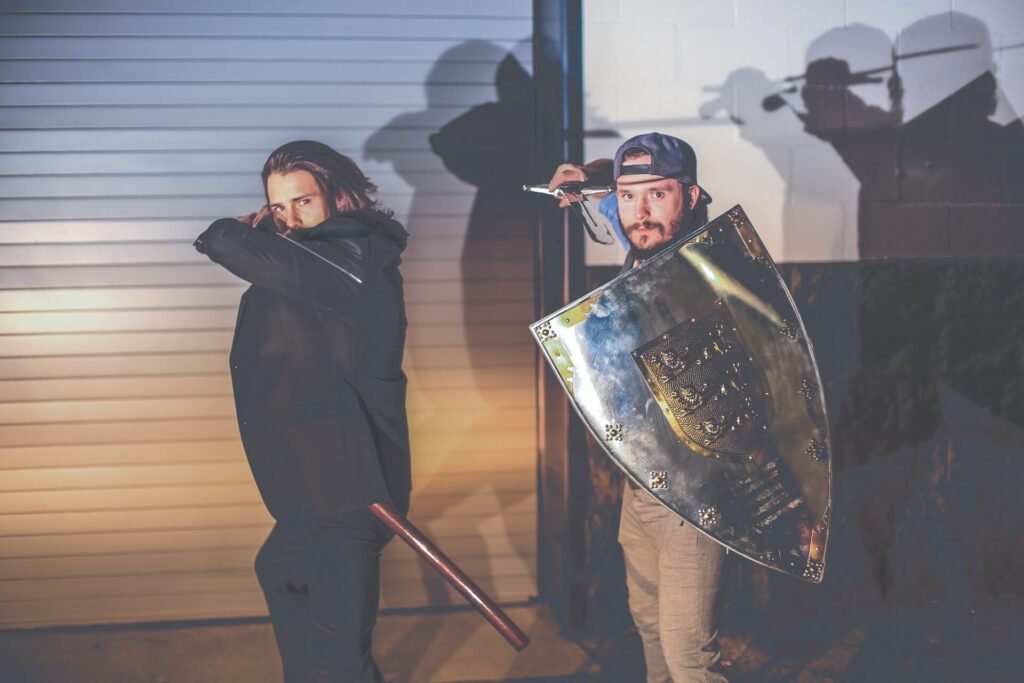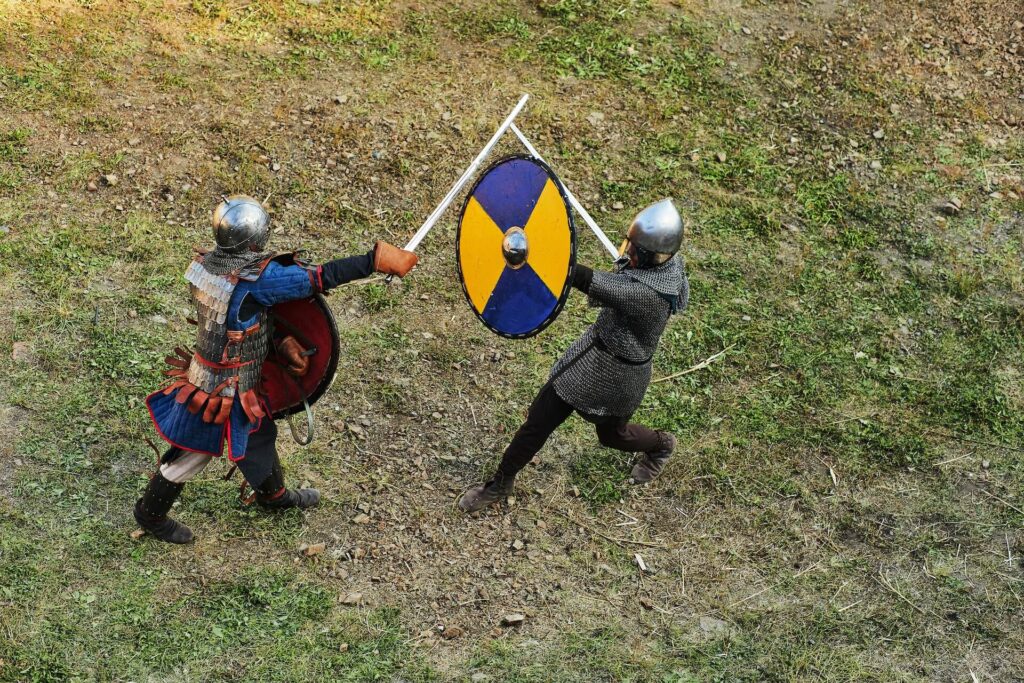
As an Amazon Associate, Modded gets commissions for purchases made through links in this post.
If you’re a fan of fantasy books, movies and games, you might have a great time trying out LARP. Live Action Roleplay is like a real-life version of a tabletop roleplaying game where players dress up as their characters to act out stories.
To get into the game, though, you’ll need a good costume. If you’re new to the hobby, you’re probably wondering how to get LARP armor. This guide covers all the basics you need to know and some good places to get your first set of gear.

LARP Armor vs Real Armor
Live Action Roleplay, also known as LARP, is a niche hobby that some people confuse with historical reenactment. At first glance, they do seem similar. Both involve dressing up in armor and both can involve staged battles with pretend weapons. They are different, though.
Live Action Roleplay vs Historical Reenactment
The main difference between LARP and historical reenactment is the content participants are acting out. LARP games or shows are completely fictional whereas historical reenactment is based on some real-world event or time period. Most LARPs are based on the High Fantasy genre, although they can include stories and settings from other niches of fiction.
This difference is important to note if you are buying armor for either LARP or historical reenactment since it drastically changes what you should look for. Historical reenactment events emphasize historical accuracy, so you won’t be able to dress up as a fantasy wizard or an elf and blend in. With LARP, you have more creativity about who your character is and what they wear.
Additionally, historical reenactment is more likely to use real armor. LARP armor does not provide protection from actual weapons like real armor would. LARP armor is only for costume purposes, not physical protection. As a result, it’s much lighter than real armor and more creative stylistically.

Live Action Roleplay vs Cosplay
LARP is also frequently confused with cosplay. There is more overlap between LARPing and cosplaying than between LARPing and historical reenactment, but they are still different activities. The main distinction is that cosplay usually involves dressing up as a fictional character outside the context of a larger group story.
A LARP is basically a large group improvised acting event. So, everyone is playing characters from the same world or story. Cosplays are usually just costumes, though, not roles for a larger story or group (although people certainly can cosplay with a group).
Additionally, cosplaying usually involves dressing up as a character from some niche of pop culture while LARPing usually involves dressing up as an original character you create (or just being yourself in a fantasy costume).
How to Choose LARP Armor
The first step to choosing your LARP armor is referring to the rules of the LARP you’re participating in. Every LARP has its own theme and safety standards. So, some LARPs might not allow metal armor while others will. Your armor might be required to be a certain thickness or cover certain parts of your body for safety reasons.
This is more of a concern in some types of LARPs than in others. Practical and “boffer” LARPs involve using stage weapons, which can include some light contact. So, for these types of LARPs, your armor will need to cover more of your body. In contrast, story-only LARPs might not require armor at all.
So, always start by reading the rules for your LARP. This is also where you’ll find guidance for the style of your armor and costume. For instance, a LARP set in a fantasy world full of magical creatures will likely have looser costume rules than a strictly Viking-age themed LARP.
Once you know the basic rules you need to follow, you can start shopping for your armor. Start by creating a budget. What is the maximum amount you are willing to spend on your armor and costume? LARP armor is fairly expensive, so even a beginner should expect to spend at least $500 on their first set.
Your budget will need to be higher if you need functional armor, which offers more protection than purely costume armor. For instance, a full set of functional metal armor can cost over $1000. If you’re joining a large LARPing community and you’re on a tight budget, consider asking around to see if anyone has used armor they might be willing to sell to you.

Where to Buy Fantasy Armor and Costumes
Beginners often have trouble figuring out where to get armor for Live Action Roleplay. There are dozens of websites out there selling costume armor, but some are more reliable than others. It’s especially important to go with a reliable seller if you need functional armor for a combat-based LARP.
In the U.S. the leading LARP shop is Medieval Collectibles. Other reliable shops for LARP gear include:
These websites are popular among LARP enthusiasts and sell a wide variety of weapons and armor. Some have better options for certain LARP styles than others, so take plenty of time to browse each shop.
Epic Armoury is also extremely popular in the LARP community, but it’s based in the EU so the shipping can be expensive to North America. Medieval Collectibles often offers the EA pieces shipped from the U.S., though, so check there if you see something you like at Epic Armoury.
Websites to avoid include Amazon, Temu, Aliexpress and Etsy. Armor from these websites is likely cheap and poorly made. Etsy can sometimes be a good source for unique or customized armor, but you have to be careful. A lot of Etsy listings, particularly for low-price armor, use fake images that don’t reflect the actual quality of the armor you’ll get. So, just make sure you carefully check the reviews for an Etsy listing or shop before buying anything there.
It’s worth noting that it’s absolutely okay to buy different pieces of your armor and costume from different stores. If you’re new to LARPing or you’re on a budget, this can be a good way to assemble a custom set of armor that’s also affordable. Most budget-friendly armor is a bit basic, but you can use clothing and accessories to spruce it up a bit.
What Material Should LARP Armor Be?
The three main types of LARP armor are textile, chain and plate, each of which uses slightly different materials. Textile armor is often called “padded armor” and includes anything that’s primarily leather or another fabric. Keep in mind that many sets of textile LARP armor are faux leather, not real leather.
Chain and plate armor both use metal, typically with a padded jacket underneath. Chainmail includes a chainmail shirt that you can wear by itself over your jacket or underneath padded or plate armor. A set of plate armor is typically the most expensive addition to anyone’s LARP costume. It includes full pieces of metal armor like chest and back plates. You may even need help to put every piece on.
There are also some types of LARP armor made of flexible plastics or foam. These are usually homemade armor pieces. They can look great, but they don’t usually provide functional protection.
Consult your LARP’s rules to figure out what material you should get. Some LARPs allow any armor material while others might require you to stick to certain functional materials for safety reasons.
How to Get Into Live Action Roleplay
Before buying your LARP armor, you need to find people to LARP with. This can be tricky, but LARP groups tend to be very welcoming to newcomers and very inclusive.
There are a few ways to find a LARP group. You can start with a simple Google search, which may pull up some LARPing organizations in your area. Another great resource is the r/LARP subreddit where you can find LARPers in your area who may be able to direct you to beginner-friendly groups or upcoming events.
It’s also worth noting that most LARP groups are for adults only. If you’re a teenager or you have a child who wants to get into LARPing, you’ll need to search specifically for kids LARP groups. One great option is the Wayfinder Experience LARP summer camp, which has programs for kids and adults.
Once you find a group or event that looks interesting, reach out to the organizer to get some info about joining. If they are okay with you joining the group, they’ll give you all of the rules and story info you need to get started.
LARPing: Fantasy Action for All Ages
LARPing has become a lot more popular over recent years. If you enjoy other fantasy games like Dungeons & Dragons or fantasy books and movies, you might have a good time trying out LARP. It’s a lot like improvised theater, but in a specifically fantasy setting. To get started, you’ll need to first find a group to join then invest in your first costume and set of armor. Remember to always consult your group’s organizer or rule book for info on armor and safety requirements.
Stay up to date with the latest by subscribing to Modded Minute.
Author
Jack Shaw is a senior writer at Modded. Jack is an avid enthusiast for keeping up with personal health and enjoying nature. He has over five years of experience writing in the men's lifestyle niche, and has written extensively on topics of fitness, exploring the outdoors and men's interests. His writings have been featured in SportsEd TV, Love Inc., and Offroad Xtreme among many more publications.






